How to Earn Money from Facebook in 2025?
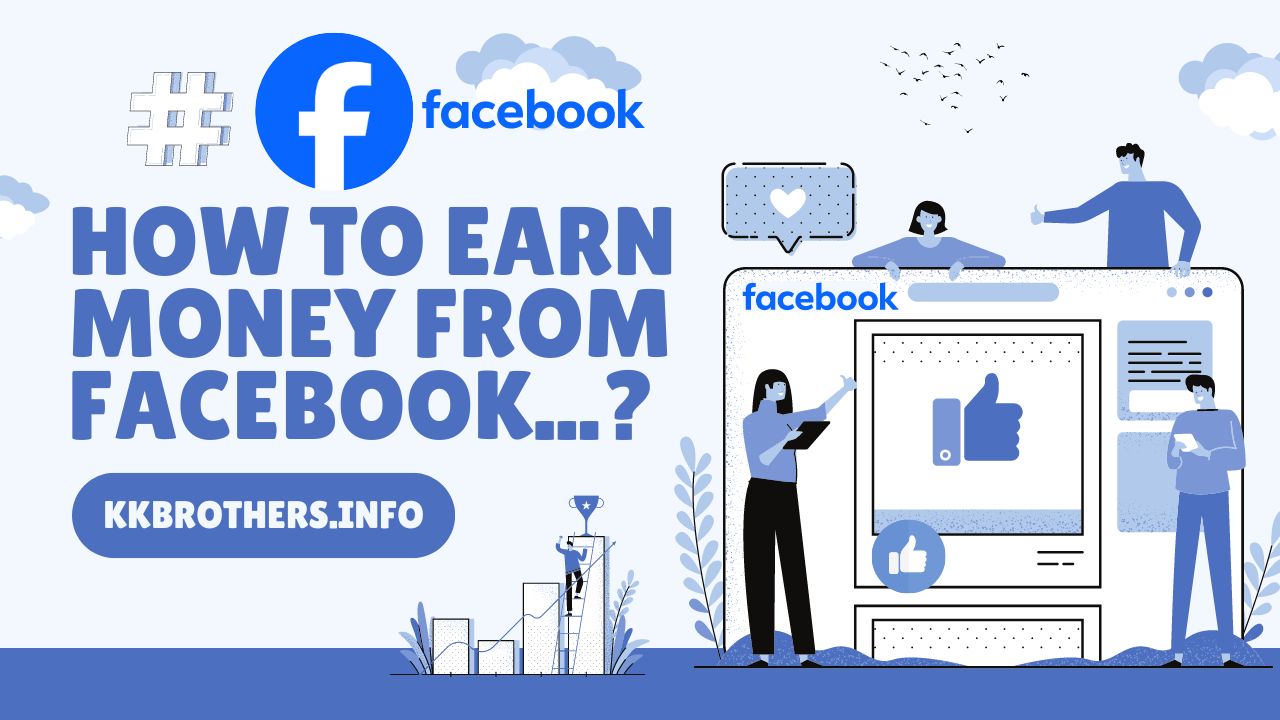
Introduction:-
My Beginnings with Facebook
Social media, in this digital period, has evolved from simple communication tools to strong income generation avenues. Of these, Facebook is one of the most versatile and broadly applied networks, with billions of users active worldwide. Its huge user base provides endless possibilities for people and businesses to generate an income from the platform. Whether it’s using an existing social media following, promoting your business, or new revenue streams, knowing how to make money on Facebook can greatly open your possibilities.
I opened a facebook account in 2009.but I did not know how to get money on facebook.but when covid-19 came in 2019 there was a lockdown in the whole world.Then I learned in my free time how to earn money from facebook? I found out that there are many ways to earn money from Facebook.so today I will teach you all these ways.
1: How to make Money with Facebook Stars monetisation?
If you get a Facebook Stars notification in your email or on Facebook then go to it. Or go to Facebook’s Meta Business Suite.
There will be a menu on your left side consisting of 3 lines, click on it and go to Monetizing.
Under the statuses in Monetizing, see page Eligibility at the bottom?
So if your page is eligible for Facebook Stars, click on it.
Select the page in which you want to enable Stars monetization.
Agree to the terms and conditions, now you can earn money using Facebook Stars Monetizing.But if you want to take the star’s earnings into the bank, you will have to add your bank account details like account name,account number or ifsc code.
2: how to earn money from facebook by uploading videos?
Users can also earn money by uploading videos on Facebook.If you want to learn that“ how to earn money from facebook videos?” So let me show you the simple way.
First Create A Facebook Page
Step 1: How to create facebook page?
step 1:- Open Your facebook and click on profile image at right side top corner.
Step 2:- Select pages option from below option in menu.
Step 3:- Select Create option on top left corner
Step 4:- Select Public page and then click on next
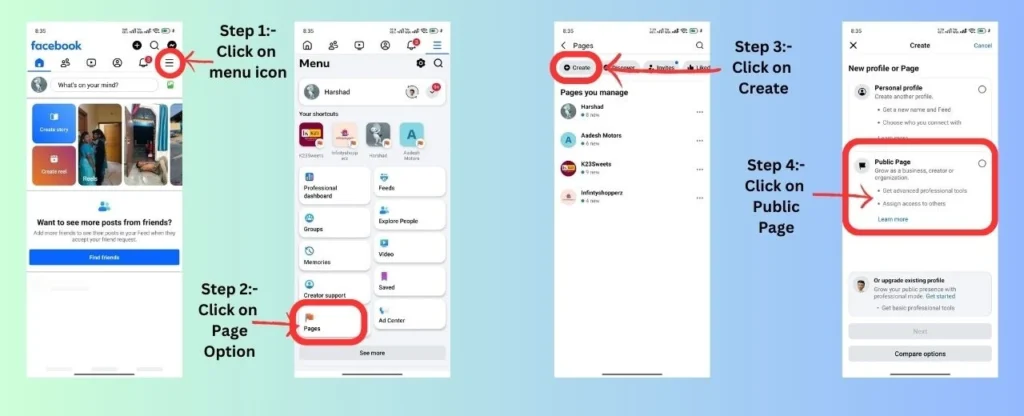
Step 5:- Type Name of your page whatever you want to keep and click on next
Step 6:- Add category of your page, you can add 3 categories in one page and click on Create
Step 7:- Now your page is created and add all other asked details like Your Location and Address (This is optional)
Step 8:- Add Profile picture and cover image from clicking camera icone.
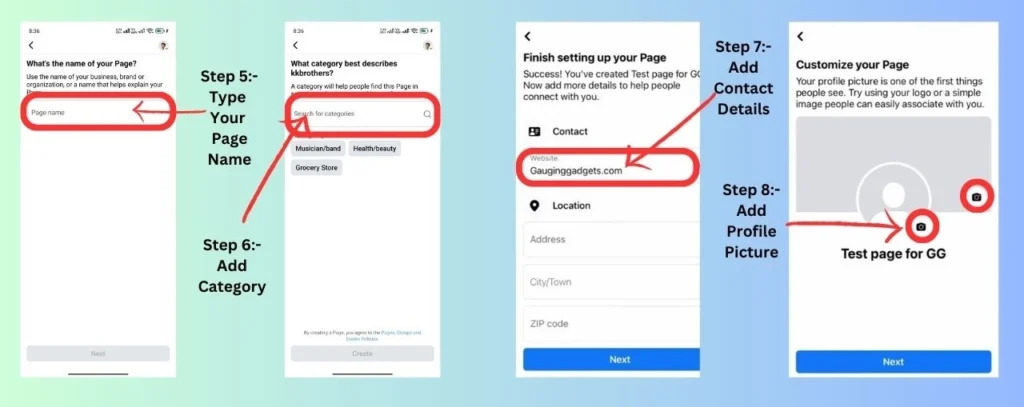
Regular Upload Video on facebook
You have to upload 1 to 2 videos on Facebook page daily.
You can earn money by editing movie videos or by uploading them on Facebook.
If you upload videos daily, your Facebook page will become fast monetized in few months And you can also earn money by uploading videos on Facebook.
3. How to Earn Money from Facebook? Use Affiliate Marketing Program

Affiliate marketing is the top and easiest way to earn money from Facebook. Affiliate marketing means you join any affiliate program and share And the commission you get on each of his sales is Affiliate Marketing.Transparency is the primary component of affiliate marketing though. To keep the trust they have earned one must always tell their audience that the links are for affiliate purposes.affiliate marketing on Facebook can be an effective way to earn money by promoting products in your facebook group or facebook page. Here is a step-by-step guide to help you, how do I start affiliate marketting on facebook:
Who wants to Earn Money on Facebook by affiliate marketing, then Facebook affiliate marketing is best way for them. To promote products of other brands and company to huge audience on online platform then facebook is best Platform for them.
What is Affiliate Marketing on facebook?
Facebook Affiliate marketing is the process of promoting a products of other brands of other company on your facebook page via posts or in form of creating reels with purchase referral link by which you will get commission when your followers or viewer buy that product from your
referral link .
How to Choose the Right Affiliate Programs:
To find best affiliate marketing, you should have knowledge of “How much referral commission is there in particular affiliate program? “, “What is the payment method and how payment is provided to user?” From all this “Amazon affiliate marketing, Earnkaro affiliate program, Extrape affiliate program” are best affiliate program.
A: Choose your products niche
- Research and Select product: Pick a product niche that you like and only have high demand in the online market.
How to share the Right Affiliate Links:
When you create a page or group of any particular “Niche” then you should share affiliate links related to that “Niche” only.
For example, if you create page or group named as “Fitness” then your followers likes fitness related tips and Suggestions so you should share “Fitness” related product affiliate links.
Affiliate Links: Obtain your unique affiliate links from the affiliate programs you joined.
Integration: Integrate these links into your posts. Make sure they are placed naturally within your content.
Disclosure: Always disclose that your content contains affiliate links. This is a legal requirement and builds trust with your audience.
Promote Your Affiliate Content
Organic Posts: Share your content on your Facebook page or group. Encourage likes, comments, and shares.
Facebook Ads: Run Facebook Ads to promote your posts or page to a broader audience. Use targeted ads to reach specific demographics interested in your niche.
By following these steps, you can effectively leverage Facebook for affiliate marketing and generate a steady stream of income through your promotional efforts
Tips for Sharing Affiliate products Links on Facebook:
Don’t share too much links of products to your Facebook page followers. In your posts write about products and also write about your purchase and using experience then naturally in between this add your product affiliate link.
4: How to Earn Money from Facebook from Selling Products and Services
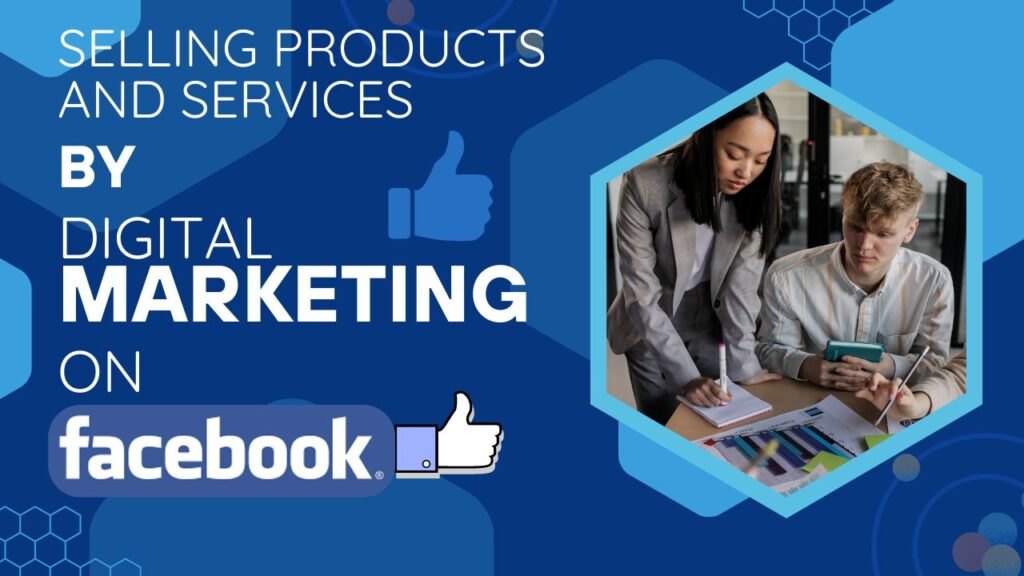
Businesses can directly sell products on Facebook through Shops and Marketplace. Facebook Shops enables the business to set up an online store on the Page, showcasing products and facilitating purchases. The second option, Marketplace, allows people to buy and sell goods locally and is the best way to support local sales. Moreover, Facebook offers a vast user base for selling eBooks, courses, and consulting sessions.
Selling products and services on Facebook involves several key steps, from setting up your platform to marketing and optimizing your sales process. Here is a step-by-step guide to help you get started:
Step 1: Set Up Your Facebook Business Page
Create a Page: Go to Facebook and create a business page. Select a category that makes sense for your company.
Profile and Cover Photos: Use high-quality images for your profile and cover photos. These should be relevant to your brand.
Step 2: Set Up Facebook Shop
How do you set up a Facebook shop?
Commerce Manager: Go to Facebook Commerce Manager to set up your shop.
Choose Checkout Method: Decide if you want customers to check out on Facebook, on your website, or via messaging.
Product Catalog: Add your products to the catalog. Include high-quality images, detailed descriptions, prices, and inventory status.
Shipping and Return Policies: Set up your shipping and return policies to inform customers about these aspects of their purchase.
Step 3: Promote Your Products and Services
Organic Posts: Regularly post about your products and services. Use high-quality images and engaging descriptions.
Facebook Ads: Use Facebook Ads to reach a broader audience. Develop specialized advertising campaigns according to behaviors, interests, and demographics.
Boosted Posts: Boost your posts to increase visibility.
Ad Campaigns: Create ad campaigns with specific goals, such as increasing website traffic or generating sales.
Facebook Live: Use Facebook Live to showcase your products or services in real-time. Engage with your audience by answering questions and offering special deals.
Step 4: Drive Traffic to Your Shop
Website and Social Media Integration: Link your Facebook shop to your website and other social media platforms to drive traffic in your facebook shop.
Email Marketing: Use email marketing to promote your Facebook shop to your existing customers.
Influencer Collaborations: Partner with influencers in your niche to promote your products or services.
Step 6: Manage Orders and Customer Service
Order Management: Use Facebook Commerce Manager to track and manage orders. Ensure timely fulfillment and shipping.
Customer Service: Provide excellent customer service by responding to inquiries and resolving issues promptly.
Feedback: Collect feedback from customers to improve your products, services, and overall shopping experience.
By following these steps, you can effectively sell your products and services on Facebook, reaching a wide audience and driving sales through this powerful social media platform.
5:How to earn Money from Facebook? by Sponsored Posts and Influencer Marketing

With the rise of influencer marketing, sponsored posts have been one of the most lucrative ways to actually get paid via Facebook. Influencers are partnered with brands to assist them create content that tells the story of their goods and services to the public. These sponsored pieces, therefore, put real money in the pocket of an influencer who has mustered a large following and is able to impact their audience to further their reach for brands. Maintaining your authenticity and collaborating with brands that share your values are crucial.
Here is a step-by-step guide on how to effectively use Facebook sponsored posts and influencer marketing:
Step 1: Understand Sponsored Posts
Define Objectives: Determine what you want to achieve with your sponsored posts (e.g., brand awareness, engagement, website traffic, or conversions).
Target Audience: Identify your target audience based on demographics, interests, behaviors, and location.
Budget: Set a budget for your sponsored posts. Decide how much you are willing to spend daily or over the campaign’s duration.
Step 2: Create Sponsored Posts
Content Creation: Develop high-quality, engaging content for your sponsored posts. This can include images, videos, and compelling copy.
Call to Action (CTA): Include a clear CTA in your post, such as “Shop Now,” “Learn More,” or “Sign Up.”
Ad Format: Choose the appropriate ad format (carousel, single image, video, slideshow, or collection) that best showcases your product or service.
Step 3: Set Up Sponsored Posts in Facebook Ads Manager
Access Ads Manager: Go to Facebook Ads Manager and click “Create” to start a new campaign.
Campaign Objective: Select your campaign objective (e.g., Traffic, Engagement, Conversions).
Ad Set: Define your target audience, budget, schedule, and placement options.
Ad Creation: Upload your content, write your ad copy, and select your CTA. Review and confirm your ad.
Step 4: Monitor and Optimize Sponsored Posts
Performance Tracking: Use Facebook Ads Manager to monitor the performance of your sponsored posts. Examine data like conversions, click-through rate (CTR), reach, and engagement.
A/B Testing: Experiment with different ad creatives, audiences, and formats to see what performs best.
Adjust Strategy: Optimize your ads based on performance data. Adjust targeting, budget, and content to improve results. To achieve better results, change the content, budget, and targeting.
Step 5: Understand Influencer Marketing
Define Objectives: Determine what you want to achieve with influencer marketing (e.g., brand awareness, reach, sales).
Identify Influencers: Find influencers in your niche who have a significant following and engagement. Ensure they align with your brand values and target audience.
Research: Look at influencers’ past collaborations, engagement rates, and audience demographics to ensure they are a good fit.
Step 6: Reach Out to Influencers
Contact Influencers: Reach out to influencers via direct message or email. Introduce your brand, explain why you want to collaborate, and outline the benefits for them.
Negotiate Terms: Discuss the terms of the collaboration, including deliverables, compensation, timelines, and usage rights. Ensure everything is clear and agreed upon by both parties.
Contract: Draft a contract outlining the terms of the collaboration. Include details about content deliverables, payment, and expectations.
Step 7: Plan and Execute Influencer Campaigns
Campaign Planning: Work with the influencer to plan the campaign. Decide on the type of content (e.g., posts, stories, videos), key messages, and hashtags.
Content Creation: Allow influencers creative freedom to create authentic content that resonates with their audience. Provide guidelines and key messages to ensure alignment with your brand.
Approval: Review and approve the content before it goes live. Ensure it meets your brand standards and objectives.
Step 8: Promote Influencer Content
Share Content: Share the influencer’s content on your brand’s Facebook page and other social media platforms to amplify reach.
Sponsored Posts: Consider boosting the influencer’s posts using Facebook Ads Manager to reach a larger audience.
Engage: Engage with the influencer’s content by liking, commenting, and sharing to encourage more interaction from their followers.
Step 9: Monitor and Measure Results
Track Performance: Use tools like Facebook Insights, Google Analytics, and influencer reporting tools to track the performance of the campaign. Track data like conversions, website traffic, reach, and engagement.
Analyze Data: Analyze the data to understand what worked well and what didn’t. Look at the ROI of the campaign to determine its effectiveness.
Feedback: Gather feedback from the influencer and their audience to gain insights into the campaign’s impact.
Step 10: Optimize and Iterate
Learn and Adapt: Use the insights gained from the campaign to optimize future influencer collaborations and sponsored posts.
Build Relationships: Maintain good relationships with successful influencers for potential future collaborations.
Continuous Improvement: Continuously refine your influencer marketing and sponsored post strategies based on data and feedback to achieve better results over time.
By following these steps, you can effectively leverage Facebook sponsored posts and influencer marketing to reach a wider audience, drive engagement, and boost sales.
6: How to Earn Money from Facebook by Creating and Selling Online Courses
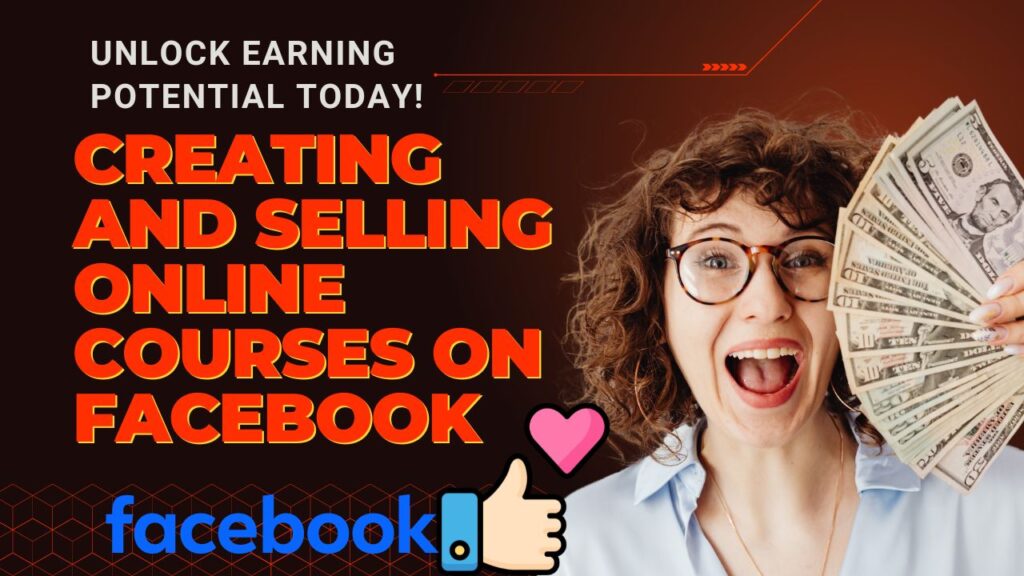
Online courses have gained much in popularity for sharing knowledge and skills. Facebook will be a fantastic medium for promoting and selling virtual courses. Visit Facebook Groups and live yourself or post to involve in your courses and the value you provide to receive student interest and to encourage signups. Building community around a course empowers learning and fosters a sense of belonging among students.
Creating and selling online courses on Facebook involves a combination of content creation, marketing, and utilizing Facebook’s tools for business. Here’s a step-by-step guide:
Step 1. Identify Your Course Topic
Research Demand: Determine a subject that you are knowledgeable in and that has an audience demand. Use tools like Google Trends, Facebook groups, and forums to gauge interest.
Define Your Audience: Identify the specific group of people who would benefit from your course (e.g., beginners, professionals, hobbyists).
Step 3. Create Course Materials
Record Videos: Use a good quality camera and microphone. Screen recording software can be useful for tutorial-style content.
Design Slides and Handouts: Supplement your videos with slides, PDFs, and other downloadable resources.
Edit Your Content: Ensure your videos and materials are clear, concise, and professional.
Step 4. Choose a Hosting Platform
Facebook Groups: Create a private Facebook group for your course participants. This allows for direct engagement and community building.
Third-Party Course Platforms: Consider using platforms like Teachable, Udemy, or Thinkific to host your course. Share links to your course on Facebook.
Facebook Shop: Set up a Facebook Shop if you want to sell the course directly through Facebook, linking to your course hosting platform.
Step 5. Set Up a Facebook Business Page
Create a Page: If you don’t already have one, set up a Facebook Business Page to represent your brand.
Optimize Your Page: Add a professional cover photo, profile picture, and a clear description of what your page and course offer.
Add a Call-to-Action: Use a “Sign Up,” “Learn More,” or “Shop Now” button to direct traffic to your course.
Step 6. Market Your Course on Facebook
Content Marketing: Regularly post valuable content related to your course topic on your Facebook page. Use videos, articles and infographics to engage your audience.
Facebook Ads: Run targeted ads to reach your ideal audience. Use Facebook’s detailed targeting options to narrow down to demographics, interests, and behaviors that match your course audience.
Engage with Facebook Groups: Join groups where your target audience hangs out. Provide value by answering questions and subtly promoting your course when relevant.
7: Offering Consultancy and Coaching
Make the most of your expertise in a certain area by using the coaching and consulting services that Facebook has to offer to succeed. In order to establish yourself as an authority and draw viewers to your posts, videos, or live sessions, include all you’ve learned. This will help you attract clients. Monetize via one-on-one sessions, group coaching, or webinars: serve value to your audience and get an income in return.
Offering consultancy and coaching on Facebook can be a powerful way to reach and engage with clients. Here’s a step-by-step guide to help you establish and grow your consultancy or coaching business on Facebook:
Step 1: Define Your Niche and Services
Identify Your Expertise: Clearly define the area in which you offer consultancy or coaching. This could be business coaching, life coaching, marketing consultancy, health coaching, etc.
Target Audience: Identify your ideal clients. Understand their needs, challenges, and goals.
Service Packages: Create service packages or offerings. Define what each package includes, the duration, and the price.
Step 2: Set Up Your Facebook Business Page
Create a Page: Set up a Facebook Business Page dedicated to your consultancy or coaching services. Choose a relevant category.
Profile and Cover Photos: Use professional and high-quality images that reflect your brand and services.
Page Info: Fill out all necessary information, including a detailed bio, contact details, website links, and service descriptions.
Call to Action (CTA): Add a CTA button like “Book Now,” “Contact Us,” or “Learn More” to guide visitors.
Step 3: Build Your Audience
Invite Your Network: Start by inviting friends, family, and professional contacts to like your page.
Content Strategy: Develop a content calendar to consistently share valuable content that aligns with your expertise. This could include tips, articles, success stories, and videos.
Engage with Your Audience: Respond to comments and messages promptly. Talk to each other in order to create a community.
Facebook Groups: Join or create Facebook groups related to your niche. Share your insights and expertise to position yourself as an authority.
Step 4: Offer Free Value to Build Trust
Content Sharing: Regularly share valuable content that provides solutions to your audience’s pain points. Infographics, videos, and blog articles might all be examples of this.
Webinars and Live Sessions: Host free webinars or Facebook Live sessions on topics within your expertise. This showcases your knowledge and provides immediate value to your audience.
Free Resources: Offer free resources like e-books, checklists, or templates in exchange for email sign-ups. This helps build your email list for future marketing efforts.
Step 5: Promote Your Services
Service Posts: Create posts that directly promote your consultancy or coaching services. Stress the advantages and provide a compelling call to action.
Client Testimonials: Share testimonials and success stories from past clients to build credibility and trust.
Facebook Ads: Use Facebook Ads to reach a targeted audience. Create campaigns that drive traffic to your booking page or website.
Boosted Posts: Boost posts that are performing well to increase their reach.
Ad Campaigns: Create specific ad campaigns with objectives like lead generation or conversions.
Step 6: Set Up Booking and Payment Systems
Appointment Scheduling: Integrate a scheduling tool like Calendly or Acuity Scheduling with your Facebook page to make it easy for clients to book sessions.
Payment Systems: Set up a payment system through PayPal, Stripe, or another platform to facilitate easy and secure payments.
Automated Replies: Use Facebook’s automated messaging to respond to inquiries instantly, guiding potential clients on how to book your services.
Step 7: Engage in Ongoing Client Communication
Messenger: Use Facebook Messenger to communicate with clients. It’s a convenient way for them to ask questions or book services.
Email Marketing: Collect email addresses and use email marketing to nurture leads, share valuable content, and promote services.
Follow-Ups: Regularly follow up with clients after sessions to offer additional support and encourage repeat business.
Step 8: Monitor and Optimize Your Efforts
Facebook Insights: Use Facebook Insights to track the performance of your posts, ads, and overall page engagement.
Client Feedback: Collect feedback from clients to understand their experience and areas for improvement.
A/B Testing: Experiment with different types of content, ads, and offers to see what resonates best with your audience.
Refine Strategy: Continuously refine your marketing and engagement strategies based on data and feedback.
Step 9: Scale Your Consultancy or Coaching Business
Expand Services: As your business grows, consider expanding your services or adding new packages to cater to different client needs.
Collaborate: Partner with other coaches, consultants, or businesses to offer joint services or workshops.
Build a Community: Create a Facebook group for your clients and prospects where you can offer ongoing support, share exclusive content, and foster a sense of community.
Step 10: Stay Updated and Compliant
Stay Informed: Keep up-to-date with the latest trends in Facebook marketing and your industry.
Compliance: Ensure your business complies with Facebook’s policies and any legal requirements related to consultancy and coaching.
By following these steps, you can effectively offer and grow your consultancy or coaching business on Facebook, reaching a broad audience and establishing a strong online presence.
7. Utilizing Facebook Ads for Revenue
Facebook ads have the potential to drive a lot of traffic to a platform that is sponsored by an affiliate program, website, or online store. Companies can target certain demographics and interests with their ad campaigns, increasing the likelihood of conversion. Any broad-based monetization strategy must include Facebook Ads since they allow for real-time tracking of ad performance for strategy changes.
Utilizing Facebook Ads to generate revenue involves strategic planning, execution, and optimization. Here’s a step-by-step guide to help you maximize your revenue through Facebook Ads:
Step 1: Set Clear Objectives
Define Your Goals: Identify what you want to achieve with your Facebook Ads. Common goals include driving sales, generating leads, increasing website traffic, or boosting brand awareness.
Key Performance Indicators (KPIs): Set measurable KPIs such as cost per acquisition (CPA), return on ad spend (ROAS), click-through rate (CTR), or conversion rate to track your success.
Step 2: Understand Your Audience
Identify Target Audience: Determine who your ideal customers are based on demographics, interests, behaviors, and location.
Create Buyer Personas: Develop detailed buyer personas to understand your audience’s needs, preferences, and pain points.
Custom and Lookalike Audiences: Use Facebook’s tools to create Custom Audiences (e.g., previous customers) and Lookalike Audiences (people similar to your existing customers).
Step 3: Choose the Right Ad Format
Ad Formats: Choose the ad format that best suits your goals and content. Options include:
Image Ads: Simple and effective for promoting products.
Video Ads: Great for storytelling and showcasing products or services in action.
Carousel Ads: Allows you to showcase multiple products or features in one ad.
Collection Ads: Ideal for e-commerce, combining a video or image with a product catalog.
Lead Ads: Designed to capture lead information without users leaving Facebook.
Ad Placements: Choose where your ads will appear (e.g., Facebook News Feed, Instagram, Messenger, Audience Network). You can select automatic placements or customize them based on your strategy.
Step 4: Create Compelling Ad Content
Strong Visuals: Use high-quality images or videos that grab attention and are relevant to your brand and audience.
Engaging Copy: Write clear, concise, and compelling ad copy. Emphasize the advantages of your offering and incorporate a compelling call to action (CTA).
Consistency: Ensure your ad visuals and copy are consistent with your brand’s voice and messaging.
Step 5: Set Up Your Campaign in Facebook Ads Manager
Access Ads Manager: Go to Facebook Ads Manager and click “Create” to start a new campaign.
Campaign Objective: Select your campaign objective based on your goals (e.g., Conversions, Traffic, Lead Generation).
Ad Set: Define your target audience, budget, schedule, and ad placements.
Budget and Bidding: Choose between daily or lifetime budget. Select your bidding strategy (e.g., lowest cost, bid cap) to control your ad spend.
Ad Creation: Upload your content, write your ad copy, select your CTA, and review your ad. Make sure everything aligns with your campaign goals.
Step 6: Launch and Monitor Your Ads
Launch Campaign: Once everything is set up and reviewed, launch your campaign.
Real-Time Monitoring: Monitor your ads’ performance in real-time using Facebook Ads Manager. Track metrics such as impressions, clicks, conversions, and costs.
Facebook Pixel: Install the Facebook Pixel on your website to track user behavior and conversions from your ads. This will also help you retarget visitors and optimize your ads.
Step 7: Optimize Your Campaigns
A/B Testing: Conduct A/B testing (also known as split testing) to compare different versions of your ads. Test variables like headlines, images, ad copy, and CTAs to determine what works best.
Adjust Targeting: Refine your audience targeting based on performance data. Narrow or expand your audience to improve ad relevance and results.
Budget Allocation: Reallocate your budget to the best-performing ads and pause or adjust underperforming ones.
Ad Frequency: Monitor ad frequency to avoid ad fatigue. If your audience sees the same ad too often, they may become less responsive.
Step 8: Analyze and Report Results
Performance Analysis: Use Facebook Ads Manager and Google Analytics to analyze the performance of your ads. Focus on key metrics like ROAS, CPA, and conversion rate.
Custom Reports: Create custom reports in Facebook Ads Manager to track specific metrics and trends over time.
Insights and Learnings: Identify what worked well and what didn’t. Use these insights to inform future campaigns.
Step 9: Scale Successful Campaigns
Increase Budget: Gradually increase the budget for successful campaigns to scale your results without compromising efficiency.
Expand Targeting: Use Lookalike Audiences or expand your current audience targeting to reach new potential customers.
Repurpose Content: Repurpose high-performing content into different formats or adapt it for new ad campaigns.
Step 10: Continuously Improve and Innovate
Stay Updated: Keep up with the latest Facebook Ads features, trends, and best practices. Facebook frequently updates its platform, and staying informed can give you a competitive edge.
Experiment: Continuously experiment with new ad formats, targeting options, and creative strategies.
Feedback Loop: Implement a feedback loop where you regularly review campaign performance, gather insights, and apply learnings to future campaigns.
By following these steps, you can effectively utilize Facebook Ads to drive revenue, reach your target audience, and achieve your business goals.
8. Create Paid Subscription offers.
Facebook page owner can activate its subscriptions plan on his page.Facebook page owners can share videos and posts with more information on their pages and get subscription fees from their followers.
If your followers take a subscription plan from PC Desktop, you will receive 100% of the subscription plan fee.And if they take a plan from a mobile phone, you will get 70% of the fee and 30% will go to their mobile provider.
9. Building an Effective Facebook Strategy
A. Content Creation
- Establish an engaged following on Facebook with relevant content. This should include a mix of posts, videos, live streaming, stories, and more. More so, understand what type of content works best for your audience and keep a regular posting pattern. The high-quality content will encourage users to engage with it or share it because it either serves, entertains, or informs them.
B. Audience Engagement
- Engagement is very key to building community and gaining loyalty. It can be through comments, messages, or even making interactive posts like polls or questions. When you get your followers to engage actively in your page, you build a sense of community and value for the audience. It may eventually result in increased engagement rates and loyalty of the audience.
C. Analyzing Insights and Metrics
Facebook Insights will provide information about the performance of your page, including reach, engagement, and audience demographics. This way, you will be able to know what works and what does not in the posted content regularly. Keep tracking these insights to enable you to make data-driven decisions on how to best optimize your content and marketing efforts.
Legal and Ethical Considerations
A. Understanding Facebook’s Policies
Complying with the community standards and policies of Facebook ensures that penalties are not issued out on you or your account suspended. This involves refraining from posting prohibited content, including hate speech, nude images, or misformation. Understand what the guidelines stipulate and ensure that your content is relevant and safe for users.
B. Transparency and Disclosure
Transparency in sponsored product and affiliate link promotions is very critical. The site discloses any sponsored content and makes known any affiliate relationships. An honest and transparent attitude toward affiliation helps to sustain your credibility and avoid serious legal implications.
C. Intellectual Property Rights
One has to be very cautious while sharing images, videos, or any such content over Facebook. It ensures the appropriate permissions or licenses for use and gives proper credit if due. It’s also important to protect your content from unauthorized use by others and know how to report or react in case of a copyright violation.
Challenges and Common Pitfalls
A. Dealing with Algorithm Changes
It’s Facebook’s algorithm that chooses what appears in each user’s news feed; therefore, this change may very well impact your reach and engagement. Knowing how the algorithm works internally and dealing with new updates is essential to maximizing visibility. This might require changing your content strategy or trying different post varieties while staying updated with Facebook.
B. Managing Negative Feedback.
Even though negative feedback is inevitable, it’s how you deal with it that really does make the difference. Even when somebody criticizes you, responding professionally and constructively will turn a possible negative experience into a positive one. You need to respond to concerns, apologize when necessary, and act on solving the problems. It basically proves you really do care about customer service and will increase your reputation.
C. Avoiding Scams and Fraud
Since scamming and fraudulent activities occur daily on social media, including Facebook, it is one’s prudence that can get one out of the hook. Among others are being wary of offers that sound too good to be true, validating business partners, and ensuring safety within the account information. Assure safe modes of payment and personal data protection.
Case Studies and Success Stories
A. Successful Facebook Pages
Many pages on Facebook have loads of followers and have been able to earn millions of dollars out of their content. Most of the time, these are Pages targeting niche topics, for example, traveling, cooking, keeping fit, or technology. Knowing what works in terms of their strategies content types, posting frequency, and how they engage with their target audience gives so much insight into exactly what has turned them into online leaders.
B. Influencer Success Stories
Many influencers used Facebook to build their brands and generate millions of dollars in revenues. Sharing real and relevant content helped them secure loyal followers, further leading to brand partnerships wherein they are asked to share sponsored posts and other promotional content. One can learn from them how to turn one follower to an earning spree.
C. Brands Leveraging Facebook for Sales
Successful sales and the acquisition of new customers through Facebook Shops and Marketplace have been recordable by brands. These case studies allude to the key drivers of success: a well-designed shop, targeted advertising, and good customer service. Businesses should, therefore, understand how these brands use features and tools available at Facebook to replicate similar success in optimizing their sale strategies.
Future Trends and Opportunities
A. Emerging Monetization Features
Facebook is constantly rolling out new tools and features to improve monetization opportunities, be it new ad formats, shopping features, or community-building tools. Keeping up with those changes and testing the possibilities they provide can get you early access to additional sources of income and always stay ahead of the competition..
B. Expanding Beyond Facebook
While it’s strong on its own, diversification decreases risks and makes the most out of earnings. Integrating Facebook with other platforms, such as Instagram, YouTube, or personal websites, increases the streams of income and aids in reaching diverse audiences. This will ensure that you are not dependent on any one particular platform, and multi-channel dominance implies more stability and chances for growth.
10. Content Monetization:
In-Shream ads:-If you are a good video crators.And your videos get more views.So you can earn money by running ads in your videos.But your video must be eligible for Facebook’s ads policy. Only then will you be able to run ads in the video.
Ads on Reels:- Just like you run in-stream ads in videos, you can also run ads in your reels.
Facebook Content Monetization:-Facebook’s Content Monetization Program allows you to earn money based on the performance of your videos, reels, photos, and text photos.
Conclusion:-
Make money on Facebook holds a lot of potential for individuals and businesses. With its millions of users, the platform is just right to help you increase your reach further and monetize it powerfully. From content creation to selling through Facebook Shop and Marketplace, running targeted advertising, or just engaging with customers via Messenger and chatbots, the ways to get there are many.
Facebook success comes from knowing the target audience, engaging relentlessly, and being able to adapt to changing trends or technologies. You can put that all together for an income flow growing using solid features on Facebook and keeping yourself updated about best practices on this dynamic platform.
With dedication, creativity, and some strategic planning, it is quite possible that any person could share in this wealth of opportunities handed out by Facebook and turn their online activity into a profitable one.
Read More:- How to Monetize Instagram Account In India in 2025?


